Nazi collaborator monuments in Lithuania
Lithuania has installed monuments to Jonas Noreika and Kazys Škirpa, figures who are still celebrated by the country’s far-right
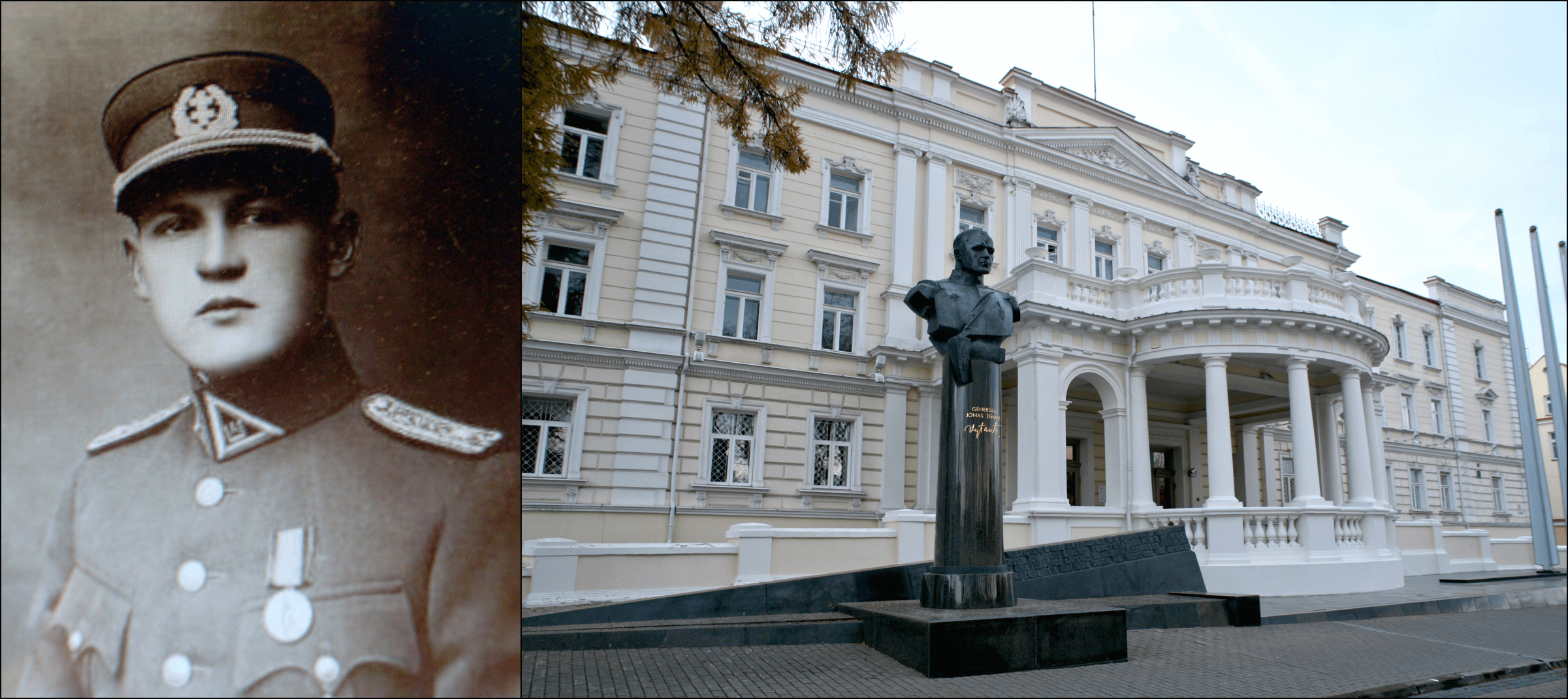
Left: Jonas Žemaitis-Vytautas (Wikimedia Commons). Right: Žemaitis-Vytautas bust outside the Ministry of National Defense of Lithuania, Vilnius (Wikimedia Commons). Image by Forward collage
This list is part of an ongoing investigative project the Forward first published in January 2021 documenting hundreds of monuments around the world to people involved in the Holocaust. We are continuing to update each country’s list; if you know of any not included here, or of statues that have been removed or streets renamed, please email [email protected], subject line: Nazi monument project.
Vilnius — In many ways, Lithuania pioneered the glorification of Nazi collaborators on a state level. It has perverted museums and tourist sites; celebrated perpetrators as national heroes; persecuted Holocaust survivors who defended themselves with pre-trial investigations for “war crimes;” destroyed a prominent author’s livelihood for the crime of admitting Lithuanians participated in the Holocaust; and is debating denialist legislation similar to Poland’s.
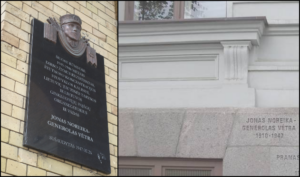
As part of the whitewashing, Lithuania installed numerous monuments, including these to brutal collaborator Jonas Noreika (1910–1947), aka General Storm. Above left is a plaque to Noreika on the Wroblewskis Library of the Lithuanian Academy of Sciences in central Vilnius; above right, his name on the wall of national heroes on Vilnius’ Museum of Occupations and Freedom Fights.
(Many thanks to Defending History founder Dovid Katz for his invaluable guidance on Lithuania and permission to use Defending History’s Lithuania photos. For more on Dovid’s crucial role in the vanguard of identifying and combating Holocaust distortion, see the methodology section.)
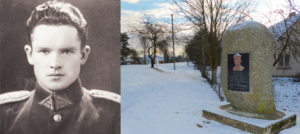
Šukioniai — Noreika is also honored with a plaque in Šiauliai, a street in Kaunas (using his nom de guerre General Storm), a school and this monument in his home village, above right. See the New York Times report, the Baltic News Network story on the U.S. State Department and Noreika and Defending History’s Noreika page.
For more on Noreika, see Salon and the Times of Israel articles by his granddaughter Silvia Foti, who set out to write a book about her grandfather, only to discover he was a Nazi collaborator.

Vilnius and Kaunas — Both cities have streets glorifying June 23, 1941. On that date, six centuries of Jewish life flourishing in Lithuania came to an abrupt and horrific end when the Lithuanian Activist Front and other nationalist groups dehumanized, pillaged and murdered Jews in dozens of locations across Lithuania within hours of the Nazi invasion of the country. See here for eyewitness testimonies.
The wave of antisemitic murder that began on June 23 fed into the subsequent genocide in which the Nazis, with the aid of local collaborators, exterminated 95-96% of Lithuania’s Jews, the highest murder rate in the Holocaust. Above right is the June 23 Street in Vilnius. Above left, in middle of the photo, LAF founder Kazys Škirpa (1895–1979) meets with Hitler.
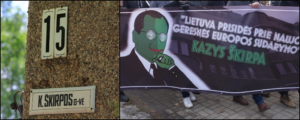
Kaunas and Namajūnai — A street honoring Škirpa in Kaunas, above left. Škirpa also has a plaque on a government military building in Kaunas and a memorial stone in his birth village of Namajūnai, erected 2016.
In the early months of 1941, while in Germany, Škirpa suggested eliminating Jews from Lithuania. After the war, he decamped to America, where he worked for the Library of Congress. His obituary in the Washington Post portrays Škirpa — the man eagerly served as an envoy to Hitler’s Germany — as a victim of the Germans. Above right, a far-right march in Kaunas with Škirpa as Pepe the Frog, a right wing meme, Feb 1, 2017. Lithuania’s far-right, like that of other nations covered here, often anchors annual gatherings to the glorification of Nazi collaborators.
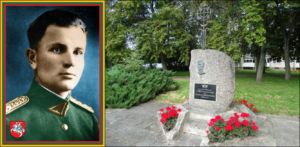
Ukmergė — A memorial to Juozas Krikštaponis (1912–1945), platoon commander in the 2nd National Labor Security TDA battalion, a paramilitary organized by the Lithuanian provisional government in service of the Nazis. These auxiliary battalions were responsible for systematic mass slaughter in Lithuania and Belarus, killing 26,000 Jews in under six months with such brutality that their overseers complained to SS head Heinrich Himmler of the excesses.
See chilling repots by Evaldas Balčiūnas in Defending History and Grant Gochin in the Times of Israel. (Thanks to Grant Gochin for the Krikštaponis image.)
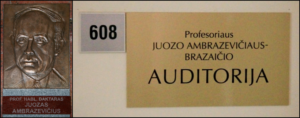
Kaunas — A bas-relief and lecture hall at Vytautas Magnus University, dedicated in 2007 in honor of Juozas Ambrazevičius Brazaitis (1903–1974), acting prime minister of the provisional Nazi puppet government. Kaunas also has a street named after him.
Brazaitis presided over Lithuania in 1941, when Jews were slaughtered by both Nazis and Lithuanian collaborators. Brazaitis signed orders confirming the creation of Lithuania’s first mass-murder camp; later, he ordered all of Kaunas’ Jews to be imprisoned in a ghetto.
After the war, Brazaitis emigrated to the West, living in Germany and the U.S. In 2012, a major scandal broke out over the state’s reburial of Brazaitis with full honors. See JTA report and Defending History’s coverage.

Kaunas — A street named after Antanas Baltūsis-Žvejas (1915–1948), brigade commander of the 2nd Lithuanian auxiliary police battalion which guarded the Majdanek concentration camp, where over 75,000 prisoners (mostly Jews) were exterminated or died of illness. See Defending History’s coverage. Above right, a Lithuanian auxiliary policeman auctions off property seized from murdered Jews, 1941.
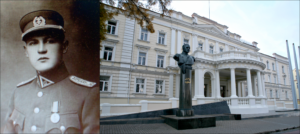
Vilnius and six other towns — In front of the Lithuanian Ministry of Defense stands an imposing black monument to Jonas Žemaitis aka Žemaitis-Vytautas (1909–1954), who served in the Lithuanian Territorial Defense Force, a volunteer militia created with the aim of providing military aid to the Nazis. Contemporaneous reports make it likely Žemaitis may have served in a Lithuanian auxiliary police battalion — one of the Nazi-organized units that were engaged in operations of mass murder of Jews. See detailed reporting by Evaldas Balčiūnas for Defending History.
Additional honors include a plaque in Šiluva and another in the Kėdainiai Regional Museum (below left); a monument in Raseiniai (below right) and another in Palanga; a bust in the memorial park of Kaunas’ Vytautas the Great War Museum; and schools in Raseiniai and Šimkaičiai.
Žemaitis is also the namesake of the state-run Military Academy of Lithuania, which coordinates with other academies in NATO nations such as the Virginia Military Institute. (See here for a bas-relief of Žemaitis on the academy.)
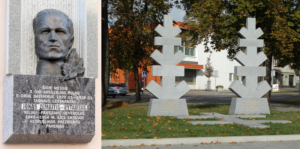
***
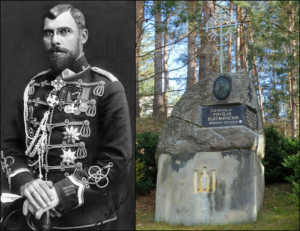
Kadrėnai and three other locales — A memorial stone to Povilas Plechavičius (1890–1973), who formed and led the Lithuanian Territorial Defense Front, a collaborationist militia created with the full support of the Third Reich. After the war, Plechavičius resettled in Chicago.
Plechavičius also has a bust in the memorial park of Kaunas’ Vytautas the Great War Museum; a memorial plaque and a cadet academy in Kaunas; another memorial plaque in Skuodas; and a square in Panevėžys.
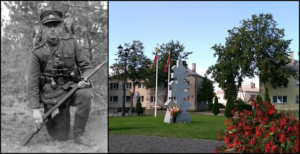
Lazdijai and six other towns — A monument to Adolfas Ramanauskas (1918–1957). Ramanauskas commanded one of the many groups in the antisemitic Lithuanian Activist Front. Ramanauskas led his LAF unit in the summer of 1941, when LAF units slaughtered thousands of Jews on their own volition, carrying out lethal pogroms even before the Germans arrived.
While there’s no direct paper trail linking Ramanauskas to murders of Jews, the fact remains he was the leader of a unit in a Nazi-allied militia whose murders and atrocities are well-documented, including by two major articles published by Lithuanian ethicist Evaldas Balčiūnas in 2014 and 2017. The connections were worrisome enough for the Simon Wiesenthal Center and the World Jewish Congress to condemn glorification of Ramanauskas. It also led authorities in New Britain, Conn. to reject plans to erect a Ramanauskas memorial (see the U.S. section).
Other honors include a memorial plaque in Lazdiljai and another in Panevėžys; a statue and square in Merkinė (Google translation here) partially funded by the Lithuanian Defense Ministry and unveiled with the participation of the defense minister; a memorial stone, sign and wood carving at the site where his childhood home once stood in Bielėnai; a street in Kaunas; a combat training center in Nemenčinė (with a bust of Ramanauskas on the grounds); and a school in Alytus (with a bust, plaque and monument on the grounds).
Below, a 2016 far-right march in Kaunas. The banner proclaims “We know our heroes!” while featuring (from left to right) Adolfas Ramanauskas-Vanagas, Jonas Noreika, Povilas Plechavičius, Kazys Škirpa, Antanas Baltūsis-Žvejas and Juozas Ambrazevičius-Brazaitis. All are either proven or alleged Nazi collaborators and/or Holocaust perpetrators. Half were welcomed by America after the war. See Defending History’s coverage. For a monument to Adolfas Ramanauskas outside of Lithuania, see the U.S. section.
Note: the Merkinė and Bielėnai monuments were added in January 2023.
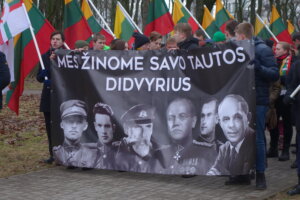
Note: the entries below were added during the January 2022 project update.
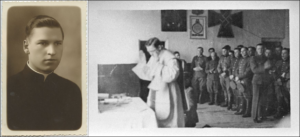
Vilkija – In 2019, the town unveiled a plaque to native son Zenonas Ignatavičius (1908–1975), priest who served as chaplain in the 12th Lithuanian Auxiliary Police Battalion. This was one of the infamous Schutzmannschaft battalions: auxiliary police units used by the Nazis to suppress partisan resistance as well as aid in perpetuating the Holocaust. The Schutzmannschaft were deployed throughout the Soviet Union, primarily in Ukraine, Belarus and the Baltics; they committed widespread war crimes on their own volition as well as on Nazi orders. According to the Simon Wiesenthal Center, Ignatavičius’ battalion was responsible for the extermination of over 15,000 Jews in Belarus. Above right, Ignatavičius leading services for men of the battalion; note the swastika at top right. For more, see the Simon Wiesenthal Center’s Nazi hunter Efraim Zuroff in the Jerusalem Post.
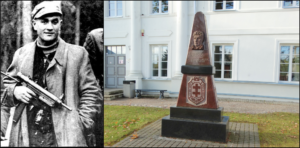
Vilnius and six other locales – In 2021, Vilnius continued its glorification of Nazi collaborators by naming a square for Juozas Lukša (1921–1951) aka Juozas Lukša-Daumantas. Lukša was a major activist in the Lithuanian Activist Front (LAF), the Nazi collaborator organization that eagerly butchered Jews across Lithuania during the German invasion of the country. One of the most horrific occurrences of this slaughter was the Kaunas (Kovno) Garage Massacre when Lithuanian nationalists publicly tortured, then murdered over 50 Jewish men using methods like bashing in heads with iron pipes. A Nazi colonel who saw the aftermath testified it was “a display of brutality that was unparalleled by anything I saw in combat during two world wars.” Numerous eyewitnesses stated Lukša was one of the murderers.
Lukša also has a school (with museum) and two streets (one with plaque) in Kaunas; a museum (with bas-relief) and monument (above, right) in Veiveriai; a sign and monument in his birth village Juodbūdis; a monument in Liubavas (Kalvarija municipality); a street in Prienai; and a Lithuanian Armed Forces training center in Rukla.
See detailed coverage by Defending History and report in Jewish Chronicle.
For more on Lithuania’s widespread Holocaust distortion, see the New York Times on Vilnius’ Holocaust museum, with quotes from Defending History’s Dovid Katz, Defending History’s page on other Lithuanian locations honoring Nazi collaborators, and Defending History’s Lithuania page.
For a first-hand account of Lithuanian authorities harassing writers and researchers who wrote about collaborators, see essays by Evaldas Balčiūnas in Defending History.
For the legal aspects, see coverage of Grant Gochin – a man who lost over 100 family members in the Holocaust in Lithuania and who’s bringing legal action against Vilnius’ whitewashing in the European Court of Human Rights. Reports in the Times of Israel and EU Today.
For the fascinating story of Silvia Foti, the granddaughter of Jonas Noreika who was told her grandfather was a hero only to discover he was a Holocaust perpetrator, see Silvia Foti’s blog and articles in Salon and the Chicago Tribune.
A message from our Publisher & CEO Rachel Fishman Feddersen

I hope you appreciated this article. Before you go, I’d like to ask you to please support the Forward’s award-winning, nonprofit journalism so that we can be prepared for whatever news 2025 brings.
At a time when other newsrooms are closing or cutting back, the Forward has removed its paywall and invested additional resources to report on the ground from Israel and around the U.S. on the impact of the war, rising antisemitism and polarized discourse.
Readers like you make it all possible. Support our work by becoming a Forward Member and connect with our journalism and your community.
— Rachel Fishman Feddersen, Publisher and CEO





























